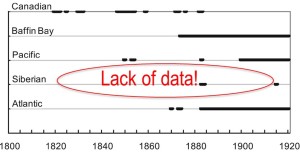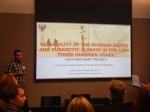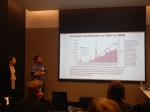
Participants of the conference
Sources of meteorological data for the area of the Barents and Kara Seas in the early instrumental period
Tomasz Strzyżewski , Przemysław Wyszyński and Rajmund Przybylak
[in:] Complex investigations of the Svalbard and Offshore Nature: Proceedings of the International Scientific Conference (Murmansk, 6-8 November 2014). Moscow: GEOS, 2014: 363-364.
One of the oldest meteorological data for Novaya Zemlya and surrounding seas come from exploratory and scientific yacht expeditions. A large part of these boats sailed from Norway. In the Regional State Archives in Stavanger, which is a part of the National Archives of Norway, logbooks were found containing series of meteorological data, such as air temperature, water temperature, atmospheric pressure, wind speed and its direction. Data from some yachts were earlier included into the ICOADS (International Comprehensive Ocean-Atmosphere Data Set) database. It was necessary to compare those logbooks and the ICOADS data. As a result of the comparison, only the data thad had not been included in the ICOADS were selected for digitization. The digitization process consisted of two steps. The first step was to copy information about the yachts’ positions from the logbooks, in an appropriate format, and then data for the area of 32-68°E and 68-80°N were only selected. GIS tools were used for this purpose. The second step of digitization was to assign the meteorological data to the yachts’ positions for the selected area. The transcribed data were also verified by merging together metadata from the ICOADS with the data appearing in the original logbooks. In this way, a verified database of uniform structure was established and temporarily named Marine Early Instrumental Dataset for the Arctic (MEIDA).
All data are presented in a grid format. The analysed area was divided into 66 grids with a spatial resolution of 2×4 degrees. The distribution of daily positions of the yachts and grid borders is shown in Figure 1. In many cases it was necessary to introduce longitudinal corrections of the yachts’ positions. During historical measurements different scales of temperature were used. Therefore, all temperature data in the database were converted to Celsius degrees. In general, the air temperature was measured six times a day (at 04.00, 08.00, 12.00, 16.00, 20.00, and 00.00 local time). In total, the database contains 3789 daily means of air temperature for the years 1867-1912. The data covered mainly the warm part of the year (from May to September). Most of the meteorological measurements carried out on 53 yachts during 67 expeditions were taken in June (881) and the fewest of them in September (291).
The main objective of the present paper is to roughly describe air temperature conditions in Novaya Zemlya and surrounding seas from 1867 to 1912 on the basis of all available early instrumental data gathered during both exploratory and scientific expeditions. Having obtained this information, the results will be compared with contemporary climatic conditions (1981-2010) to estimate the range of air temperature changes between historical and present times.

Variability of the Russian Arctic and Subarctic climate in the last three hundred years. Data recovery project.
Przemysław Wyszyński, Tomasz Strzyżewski and Rajmund Przybylak
[in:] Complex investigations of the Svalbard and Offshore Nature: Proceedings of the International Scientific Conference (Murmansk, 6-8 November 2014). Moscow: GEOS, 2014: 366-364.
According to climatic models, in the next few dozen years, the biggest changes in climatic conditions (anthropogenic warming) should occur in the polar regions. Models are based mainly on the gridded and reanalysis (retrospective analysis) data, which are in turn based on the input measured data from the 20th century, when the Arctic was in the ‘warm’ state. Moreover, studies based on the proxy data suggest that thermal conditions in the Arctic were very cool in the past centuries. Information from reanalysis and proxy data stand in non-compliance with the latest reconstructions that use the early instrumental data, which indicate that climate changes in the historical period, governed mainly by natural factors, did not exceed the range of the variation observed today. Therefore, what is the true variability of the climate and direction of its changes in the polar regions? We believe that any early instrumental data and descriptive records reflect in more accurate way the real weather conditions in a more accurate way.
The purpose of this project entitled „Variability of the Russian Arctic and Subarctic climate in the last three hundred years” is to conduct a comprehensive analysis of spatial and temporal climatic conditions in the Russian Arctic and Subarctic during the 18th, 19th and early 20th centuries on the basis of early instrumental measurements and descriptive records of weather conditions, in terms of their use for the assessment of climate changes between historical and contemporary periods.
It is expected that also in this respect the variability of the particular meteorological elements (air temperature, atmospheric pressure, wind speed, humidity) in the 18th and 19th centuries will not exceed the variability observed today. The research results will be useful to improve existing reanalysis and climatic models.
A current significant warming of the Arctic is a fact. However, we do not know how its ecosystem will behave in the future. There are too many feedbacks in the Earth climate system which are very difficult to model. Furthermore, the existing General Circulation Models (GCM) are often based on input gridded data that are burdened with a considerable error, especially as regards high-latitude areas. Therefore, research undertaken on climate reconstructions based on early instrumental data or descriptive records is becoming increasingly important.
In the Arctic, the regular instrumental meteorological observations until 1920 were very rare. Only 5 Greenland stations and Malye Karmakuly on Novaya Zemla have long records of meteorological data that started in the second half of the 19th century (Przybylak et al. 2010). Therefore, all available data before 1920 are relevant to assess the fluctuations and changes of the Arctic climate. This fact has encouraged many researchers to undertake ‘data retrieval’ from the early instrumental period for the Arctic and Subarctic. The majority of the research work undertaken up to now have been directed towards the reconstruction of the air temperature and atmospheric pressure in the Atlantic and American regions of the Arctic. The historical source materials (diaries of expeditions, logbooks, etc.) were pointed out as a very useful source of data in the reconstruction of the Russian Arctic climate (Klimenko and Astrina 2006). The reconstruction of the air temperature back to 1435 based on early instrumental and dendrochronological data were made by Klimenko (2008, 2010). However, the scope of his work was narrowed only to the European part of the Russian Arctic and Subarctic. So far, no detailed research based on early instrumental data has been carried out concerning other meteorological elements for the entire area of the Siberian Arctic.
Very good results have been recently obtained in the Twentieth Century Reanalysis Project, (20CR, Compo et al. 2011) a reconstruction of thermal, precipitation and many other fields of meteorological variables based on described surface pressure fields. The 20CR dataset provides meteorological variables from 1871 to the present at 6 hourly temporal and 2° spatial resolutions. Therefore, it is possible to study not only the long-term trends, but also the short-term extreme events such as hurricanes (Brönnimann et al. 2012).
The quality of 20CR reanalysis and gridded reconstructions depends on the availability and quality of raw pressure data assimilated (ensemble Kalman filter, Compo et al. 2006) into a model. Unfortunately, very little information about atmospheric pressure from the ‘high’ Arctic, especially the Russian Arctic (Fig. 1), collected during the nineteenth-century polar expeditions, were assimilated into the second version of the 20CR.

Temporal distribution of the atmospheric pressure observations in the climatic regions of the Arctic from 1801 to 1920 (Przybylak et. al. 2012, modified)
Temporal distribution of the atmospheric pressure observations in the climatic regions of the Arctic from 1801 to 1920 (Przybylak et. al. 2012, modified)
Validations of the 20CR conducted for the area of the Arctic (Brönnimann et al. 2012, Przybylak et al. 2012) confirmed the presence of considerable errors (Compo et al. 2011) in 20CR for high latitudes in the historical periods.
Recently, a large quantity of pressure data digitized at the NCU Department of Climatology within the ACEIP (History of the Arctic Climate in the 19th Century and the Beginning of the 20th Century based on Early Instrumental Data) and AWAKE (Arctic Climate and Environment of the Nordic Seas and the Svalbard-Greenland Area) projects, have been incorporated into the 3rd version of the International Surface Pressure Databank (ISPD, Yin et al. 2008), and will be used in the new version of the 20CR.
In the scientific community there is a constantly reiterated call for further exploration and recovery of the historical meteorological data for the Arctic. Obtaining new reliable data for the Russian part of the Arctic under the proposed project will be important to achieve these intentions. The proposed research presented at the latest 6th ACRE (Atmospheric Circulation Reconstructions over the Earth, to learn more about ACRE initiative see Allan et al. 2011) Workshop – Applications of Reanalysis Products (18–20 November 2013, Lisbon, Portugal) and IASC (The International Arctic Science Committee) workshop on Data Rescue, Citizen-Science and Collaborative Research (11th & 12th November 2013, Reykjavik, Iceland) were met with an enthusiastic reception of the scientists working in the field of historical climatology and reanalyses.
Our intention is to improve the next version of the 20CR and develop SIRCA (Sparse Input Reanalysis for Climate Applications). The high temporal resolution of the 20CR enables us to make comparisons of extreme weather situations (measured or described in the logbooks and diaries of the polar expeditions) with the data presented in the 20CR.











